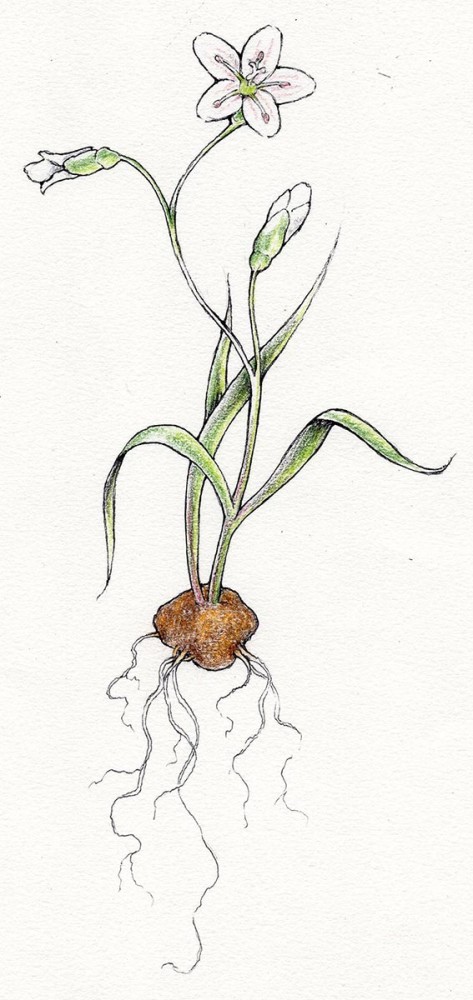If you spend time foraging, you can’t help but be aware of how abundant – and yet, how ephemeral – food can be on the landscape. This is true any time of year, but especially when winter melts into spring. Then, you feel that seeming contradiction in your bones. And the plant in our region that perhaps best symbolizes that fleeting bounty is the spring beauty.
Lovers of wildflowers will already know its showy blooms. Spring beauties’ five symmetrical white petals are laced with pink. Each stem has one pair of delicate, narrow, smooth leaves. The plants are easily crushed or bruised. Two species occur in our region: Claytonia virginica and Claytonia caroliniana. They differ most obviously in the width of their leaves. Both are edible.
Spring beauties are picky about where they’ll grow. They like the undisturbed ground of mature forests with lots of moisture and rich soil. Look for rock outcroppings rich in calcium and other soluble minerals that leach into the surrounding soils. But when you look is as important as where: Spring beauties are ephemerals, plants that complete their lifecycles in just a few weeks in spring, taking advantage of that brief window between the thawing of the soil and the shading of the forest floor by the emerging leaves of trees. Look for spring beauties when you look for wild leeks and trout lilies.
The raw leaves, flowers, and stems are all edible, with a texture unlike that of any cultivated green that I know, but the spring beauties are sought after mostly for their unusual starchy roots. If you carefully loosen the soil around the base of a spring beauty’s stem, you’ll find a thin filament of root that leads several inches down to a nickel- or dime-sized swollen structure. Usually several stems are attached to a single one of these curious, tiny, potato-like nubs that some call “fairy spuds.”
To harvest these roots, leave the shovel at home. It turns too much soil at once and cuts the thin roots, making the edible nubs difficult to find. Some use a garden trowel, but I prefer using a sturdy stick whittled to a beveled, spoon-shaped point that I drive into the ground to loosen the soil. Then I sieve the earth between my fingers, catching the filaments and following them to the fairy spuds.
Harvesting these tiny roots is slow work. As when harvesting wild strawberries, an afternoon might yield only a large handful. At first, it may seem that such a tiny return isn’t worth the effort. But reserve such judgements until after you’ve tasted the spuds. Peel them first. (This is easier than one might think.) There is no flavor among cultivated foods that is quite like the sweet, almost creamy, taste. I recommend boiling your first harvest for five to ten minutes. Enjoy with a bit of butter and salt. Later, try chopping and frying them or roasting them.
Spring beauties are delicate in another sense. Large populations of spring beauties can carpet the forest floor for acres. Such bounty can seem endless, but it is also fragile. Remember that the impact of root harvest is high on spring ephemerals. Only gather spring beauty roots when they are abundant. It may take several years for substantial roots to grow, so replant small spuds for the future. Spread your harvest to reduce your impact in any one place. Take on the responsibility of becoming a protector and caretaker of local populations; your harvest should be a tiny fraction of what you see.
To gather spring beauties is to celebrate their incredible abundance while also honoring how delicate they really are. Harvest wisely.


